Effective whitetail hunters study how deer movement changes by month and time of day throughout the hunting season. In this article, Clint Casper breaks down deer hunting tips to help you make the most of early, peak, and late season hunts. He also describes how to adjust your tactics for morning vs. evening hunts.
Prepare for the Season
Try onX for free.
Early Season Deer Hunting Tips
Your early season hunting success often depends on how much homework you did during the summer months. Instead of sipping cold beers every night and watching baseball games or boating, which we all love, a wise deer hunter will spend evenings glassing areas for velvet bucks.
Learning as much as you can about a buck over the summer gives you the best chance at tagging him the first week of the season when his summer pattern is still somewhat present.
Here are a few early season deer hunting tips, first by month, then by time of day.
August: Early Insights
- Get Eyes On ‘Em: Let trail cameras and glassing tell you a buck’s story. Start paying attention to what wind a buck favors, as well as which direction he comes from in the evening (to understand where he’s feeding) and where he heads in the morning (to understand where he’s bedding).
- Identify Water Sources: Pretty much anywhere you go, August is a hot one. Note where you find water as deer will be looking to quench their thirst.
- Be Mindful of Scent Control: Especially in muggy areas, odors can linger and break your cover. Consider scent control tactics.
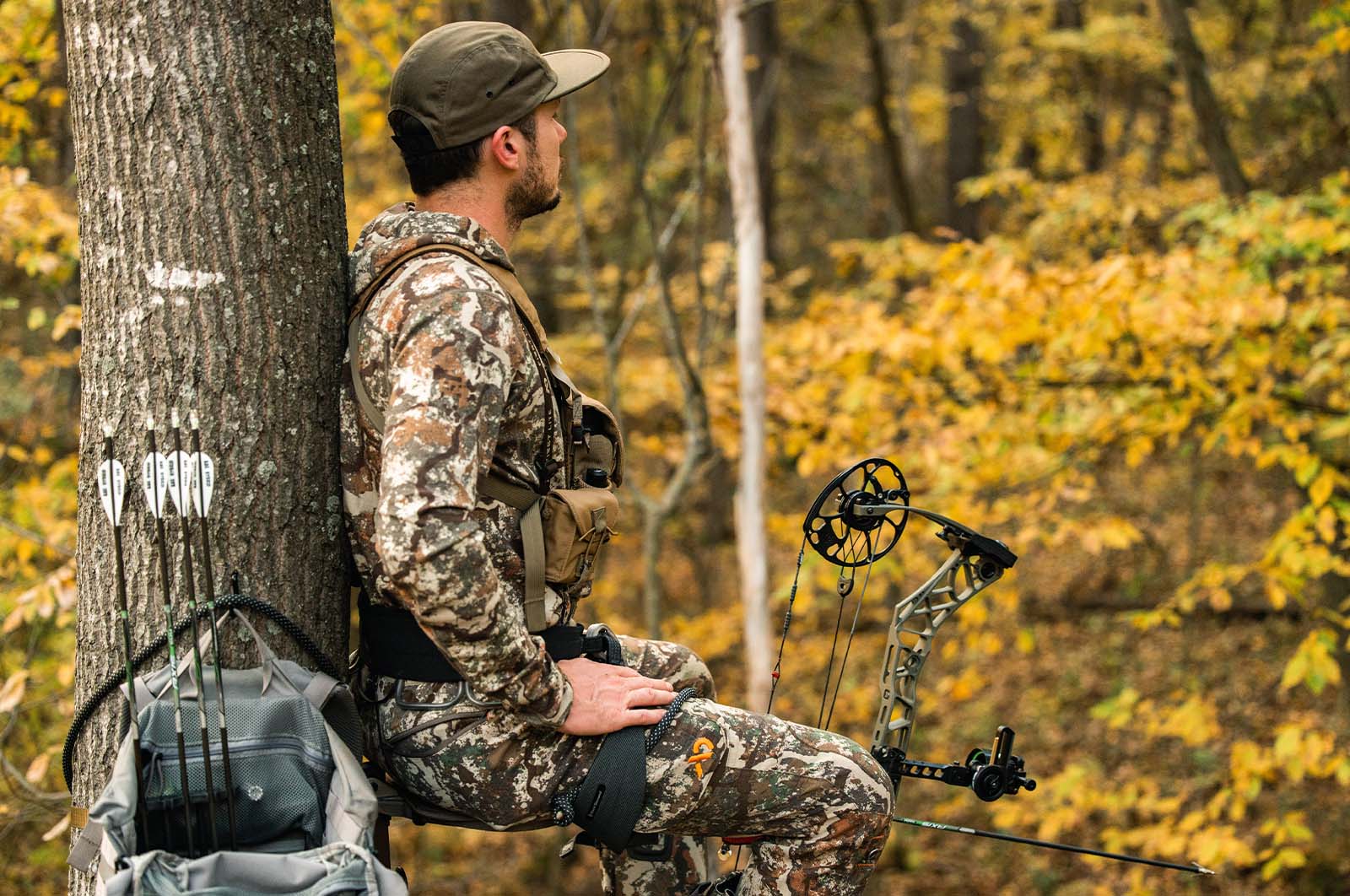
September: Shifting Deer Patterns
- Watch for Behavior Changes: While summer patterns may still be prevalent in September, buck behavior and patterning begin to shift. Velvet has come off and a pecking order of dominance is being established.
- Expect Movement: Some bucks will relocate. If your buck has disappeared, chances are he found an area with better food, water, or bedding areas to call home.
- Locate Hot Sign: Trail cameras, glassing, and on-foot scouting will be your best friends. Find thick cover near high-quality forage for a good starting point to relocate a buck.
- Capitalize on Predictability: If your buck is still on a pattern, capitalize immediately. Let his preferred wind tell you where to set up.
- Look for Food Sources: With food sources abundant, a buck’s patterns will likely shift from week to week. Apples, oaks dropping, and combined agriculture fields should all be on your radar.
Morning Deer Hunting Tips: Early Season
Your goal when morning hunting in the early season is to beat a buck back to his bed, slipping into his bedroom undetected while he’s still out feeding in the morning darkness. With the correct wind direction, this approach can be quite effective as deer are still following consistent patterns. By knowing where a buck likes to feed and bed, as well as what wind direction works best for him, you can predict deer movement and set yourself up for a shot opportunity as he walks past you heading back to bed down for the day.
It is critical to have a good entry and exit strategy planned out for a hunt like this. Often an overlooked piece of the puzzle, how you get into your tree stand and back to your truck for any given hunt can foil not only that hunt, but future hunts as well. Bumping deer while making your way to or from your treestand can drastically shift a buck’s patterns. Use the Hunt App’s Tracker to plan covert routes you can reference in the dark and share with hunting buddies.
Evening Deer Hunting Tips: Early Season
Typically, in the early season, I am strictly an evening hunter because it’s often hard to slip into a spot and catch a buck headed back to bed in the morning without alarming him and other local deer.
Whether glassing or analyzing trail camera photos, I pay close attention to the wind direction a buck prefers to show up in during daylight and his direction of travel to and from my camera or glassing spot. By learning where he likes to bed and feed, as well as what wind he prefers, I can put together a good plan for that first week of the season.
In the early season, food is changing constantly, so I’m taking note of the best available food sources. I also look for water sources and north-facing slopes for bedding. The early season tends to be hot and the north slopes, which receive the least amount of sunlight, will be the coolest.

I pay close attention to the wind direction a buck prefers to show up in during daylight and his direction of travel to and from my camera or glassing spot.
Peak Season Deer Hunting Tips
During the rut, the main focus is to be in the woods as much as possible. Below are a few tips to capitalize on your October and November morning and evening hunts.
October: Keep an Eye On the Does
- Find Fresh Sign and Food Sources: Come October, key in on the freshest deer sign and hottest food sources. At no time will there be more food available for a buck than right now. Look for apples dropping, oak trees producing, and corn and bean fields coming off. These spots will only be hot for a short time before something else takes its place.
- Track Does: Start tracking where does are bedding, feeding, and frequenting, especially later in the month. Bucks will be changing feeding and bedding locations to keep in lock-step with the does and to maintain access to the best feed available.
- Spot Buck Sign: Continue to keep your eye peeled for scrapes and rub lines, as they’re a sure sign you’re on the right track.
November: Funnels, Thickets, and Food
November is all about the ladies and I like to break the month into three parts:
- Early November: This timeframe is my absolute favorite because bucks are covering a lot of country searching for that first girlfriend of the year. You just never know what buck might turn up. Natural terrain funnels, like a saddle or creek drainage as well as pinch points such as a gap in a fence or shallow crossing in a creek, are great bottlenecks that funnel movement and are awesome spots to hunt.
- Mid-November: The most does will be bred during this timeframe, so look for doe bedding areas and thickets that a buck would lock down a doe in. Mid-month can be a challenging time for a hunter, as a lot of bucks are locked in on a doe until she’s bred, and only then will he start searching again. Your best bet is to put as many hours in the stand or blind as possible, as your opportunity can happen at any time.
- Late November: Bucks are actively searching for those last few does to breed. They know their timeframe to breed is winding down, so they’ll start covering a lot of country again. Food is also starting to be important for the deer herds, as bucks have lost a lot of weight during breeding season. The best available food sources will have the most deer activity during this time. Locate these feeding zones and the bucks will be there.
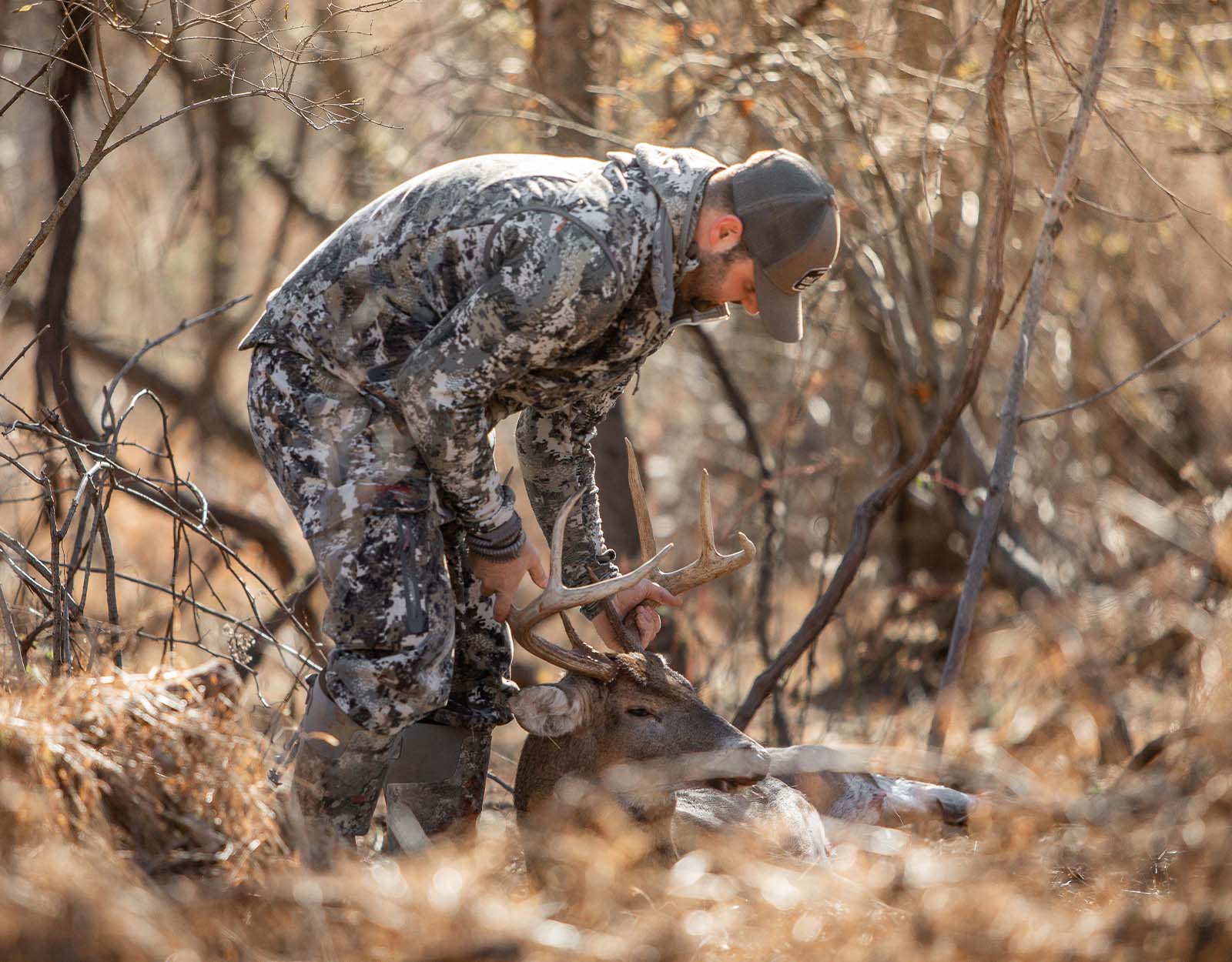
Morning Deer Hunting Tips: Peak Season
Come late October, I start to get serious about morning hunting. Buck activity is nearing its peak as doe breeding cycles become closer and closer. Bucks are moving more in the daylight trying to find that first estrous doe, and are generally covering more ground. This is also the time of year to hunt scrapes, which generally start to show up in mid-October. By the end of the month, hunting over a scrape is a viable option if that scrape is being checked daily.
In peak season, mornings can provide an opportunity to cash in on rutting activity that has spilled over from the previous night. I typically focus on doe bedding areas in the mornings during the rut, as bucks will be cruising the downwind edges of these areas looking for an estrous doe. Stay in your tree as long as you can—10 AM to noon can be a fantastic time to catch a buck scent checking from doe bedding area to bedding area.
Evening Deer Hunting Tips: Peak Season
Once October rolls around, especially the end of the month and into November, I switch gears drastically when it comes to hunting evening bucks. Where before I was focused on food and water, which are still important, I am now focused on where doe groups are feeding and bedding. For bucks, the urge to breed has taken over and they’re now waiting on the first hot doe to come into estrus. If you want to find the bucks, find the does and they will be there.
Crops are also coming off and acorns are dropping, so I use the Hunt App to locate mast trees and local farm fields to see where the hottest and most readily available food sources will be now. This is where the does will be and where bucks will now be spending a lot of time.
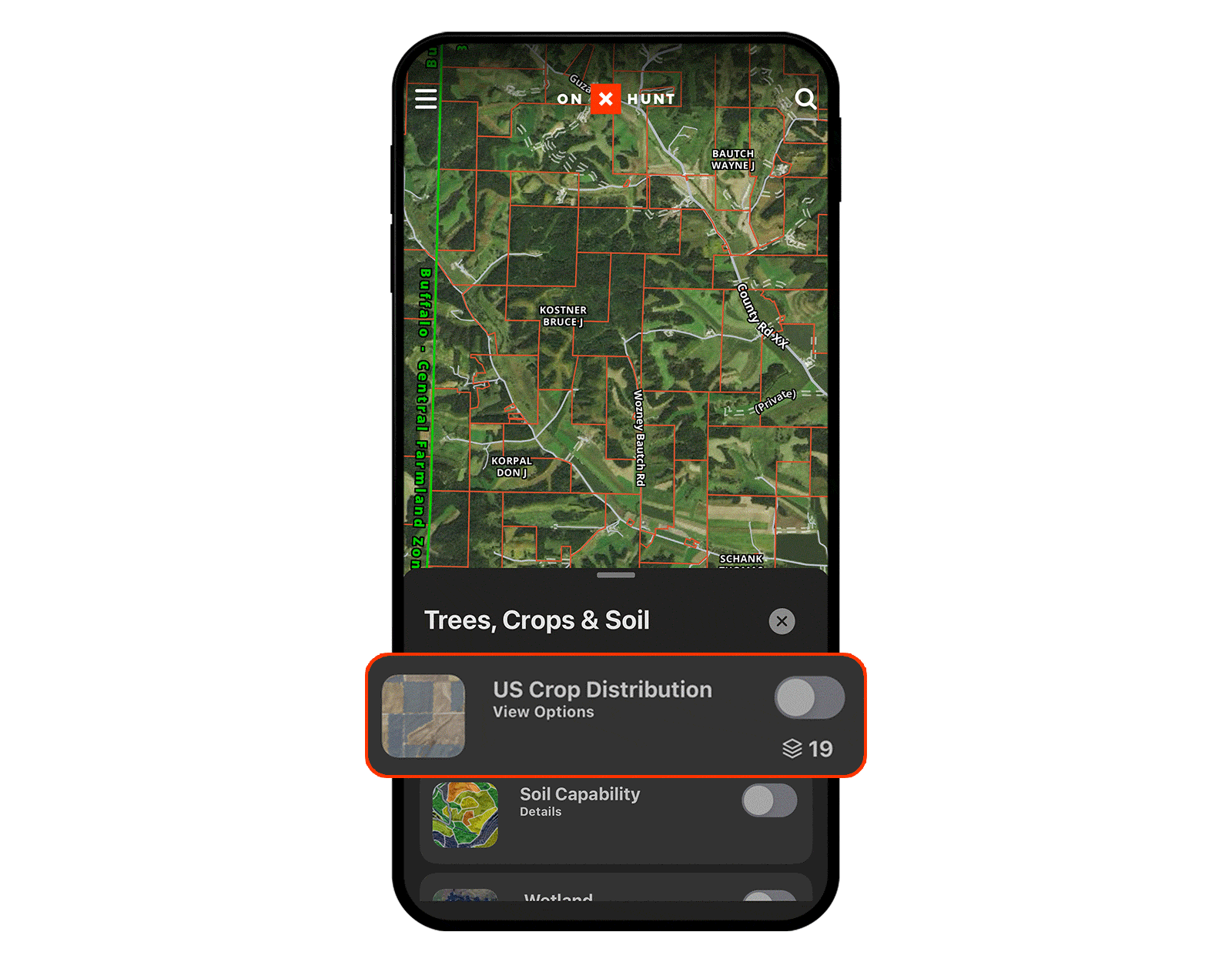
I use the Hunt App to locate mast trees and local farm fields to see where the hottest and most readily available food sources will be now.
Rubs and scrapes should be a dead giveaway that bucks are using and frequenting the area and I would advise hunting the hot sign immediately. During peak season, things can change fast. A cornfield can get combined and become the hottest ticket around for feed, or a group of does could come into heat. Both of these scenarios would make an area extremely hot and you want to hunt these spots before they go cold again.
If the action is slow and the sign isn’t fresh, move. Don’t be afraid to be aggressive this time of the year, as bucks are constantly on the move and patterns are hard to come by.
Late Season Deer Hunting Tips
In the late season months, a buck is at his most vulnerable, with some losing up to 30% of their fat reserves and body weight from chasing does during the rut. He is now in full survival mode. If you’re going to wrap your tag around this warrior, you better have your ducks in a row.
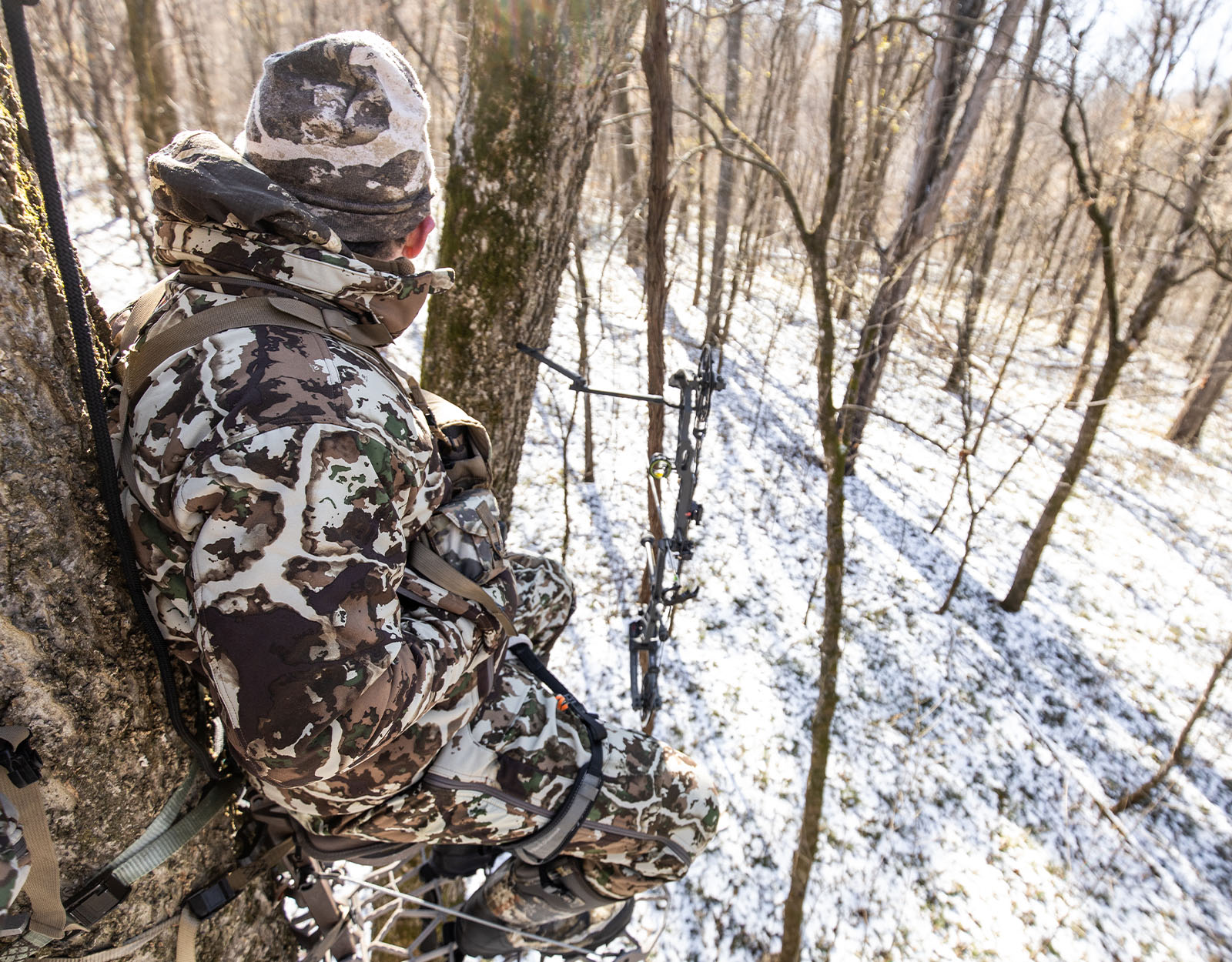
December and January: Pressured Bucks
Toward the end of the season, whitetail bucks have grown wise to hunters’ strategies. For months, these animals have been pressured by gun, bow, youth, and muzzleloader hunters on top of their day-to-day predators like coyotes. Here are a few tips to get past a deer’s keen senses.
- Switch Back To Trail Cameras: To replenish lost calories and fat reserves, a buck switches gears from breeding back to feeding and bedding. During this time of the year, I’m doing the least amount of on-foot scouting and instead let trail cameras do my dirty work. Place trail cameras on the best food sources available and close to the best bedding areas.
- Analyze Intel: Once you locate a buck, variables like the direction of travel, weather patterns, wind direction, and barometric pressure can help tip the odds in your favor.
- Evaluate Your Gear: Do a late season gear check. Shoot your bow with winter clothes on. Make sure your bow hangers and stands don’t creak. Nothing can be left to chance during this time when deer are on high alert at all times.
Morning Deer Hunting Tips: Late Season
I typically do not hunt mornings during the late season because the risk versus reward is too high for my liking. But, there have been a few times where I had the perfect scenario. Let me explain.
A few years ago, I located a standing bean field on a nearby farm and gained permission to hunt the land. With cold temps and snow covering the ground, I knew deer would be traveling for miles to come to this last standing crop field. I put up trail cameras and jumped on my onX Hunt App looking for south-facing slopes. Come late season, south-facing slopes get the most sunlight and will produce the best bedding for a worn-down buck.
A few good-looking south-facing slopes were on nearby properties, so I knew local deer would be feeding on the property I could hunt. My cameras showed a pile of deer, including one really great buck that was showing up late in the evenings and staying until morning light. My guess was he was traveling some distance in the evenings from his bed and spending all night in the beans feeding. This was the perfect scenario for a morning hunt. I could slip into an adjacent woodlot from a side entrance, which wouldn’t spook the deer feeding in the bean field. I would then sit in the darkness and wait until daylight for the deer to filter back past me, headed for the neighbors’ south-facing slopes.
On my second morning hunt, I got my opportunity on an old, bruiser buck and made a perfect 27-yard shot. These are the scenarios where a late season morning hunt is worth the bigger risk.
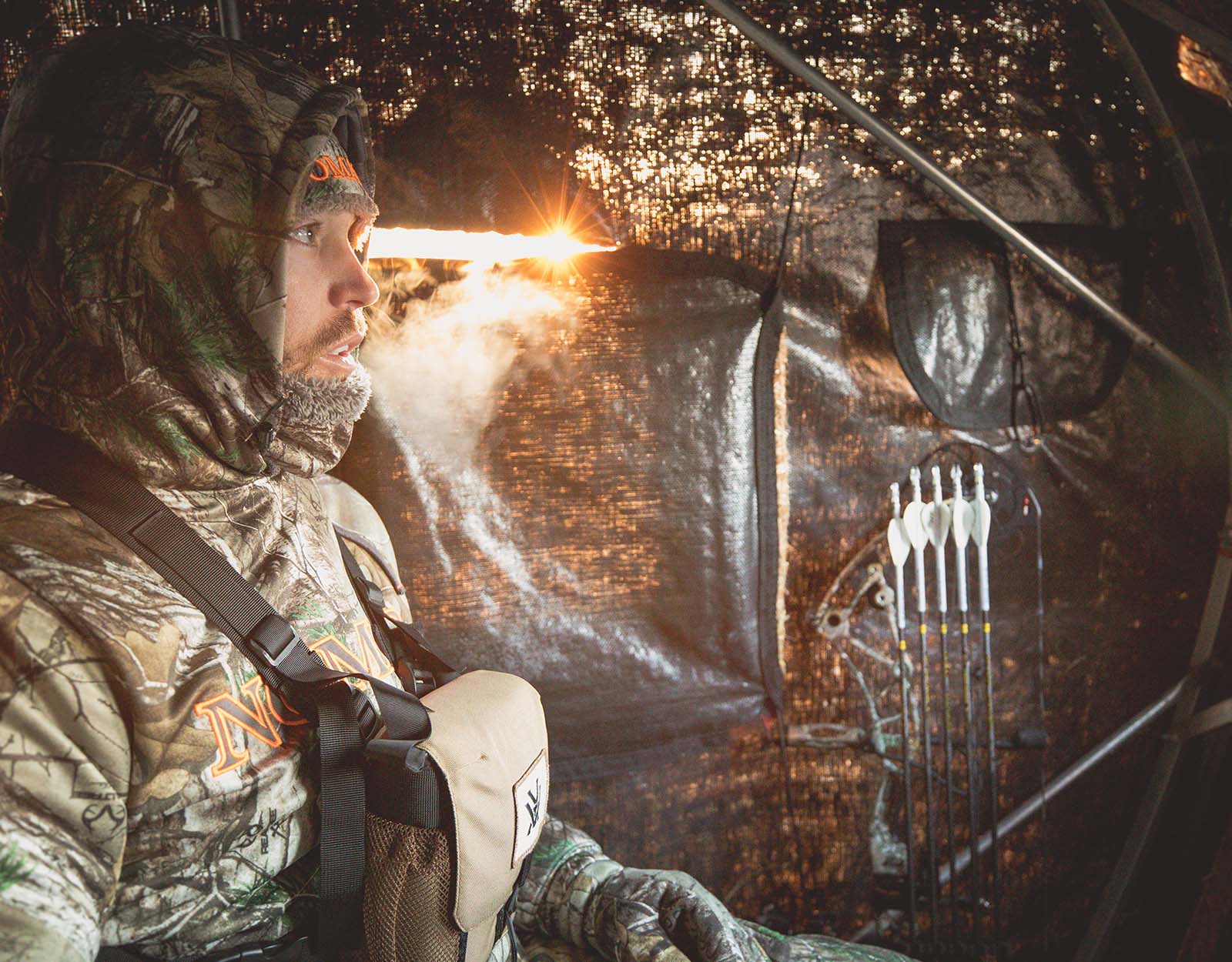
I typically do not hunt mornings during the late season because the risk versus reward is too high for my liking. But, there have been a few times where I had the perfect scenario. Let me explain.
Evening Deer Hunting Tips: Late Season
During the late season, evening hunts are my absolute favorite, and for good reason. In my opinion, evenings are your best bet to get into an area undetected. Due to bucks losing weight and body fat during the rut, food sources are key now, as well as good bedding areas to protect them from the elements. Focus on standing crops, late dropping mast trees, thermal cover, and south-facing slopes.
Prepare a plan that allows entry and exit with the wind to your advantage. Bucks will be patternable this time of the year, with a strict bed-to-feed and feed-to-bed pattern.